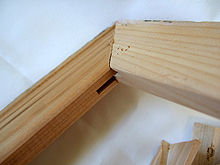
Oil painting is a painting method involving the procedure of painting with pigments with a medium of drying oil as the binder. It has been the most common technique for artistic painting on canvas, wood panel or copper for several centuries, spreading from Europe to the rest of the world. The advantages of oil for painting images include "greater flexibility, richer and denser colour, the use of layers, and a wider range from light to dark". But the process is slower, especially when one layer of paint needs to be allowed to dry before another is applied.

Printmaking is the process of creating artworks by printing, normally on paper, but also on fabric, wood, metal, and other surfaces. "Traditional printmaking" normally covers only the process of creating prints using a hand processed technique, rather than a photographic reproduction of a visual artwork which would be printed using an electronic machine ; however, there is some cross-over between traditional and digital printmaking, including risograph.

Canvas is an extremely durable plain-woven fabric used for making sails, tents, marquees, backpacks, shelters, as a support for oil painting and for other items for which sturdiness is required, as well as in such fashion objects as handbags, electronic device cases, and shoes. It is popularly used by artists as a painting surface, typically stretched across a wooden frame.

Joinery is a part of woodworking that involves joining pieces of wood, engineered lumber, or synthetic substitutes, to produce more complex items. Some woodworking joints employ mechanical fasteners, bindings, or adhesives, while others use only wood elements.

A mortiseand tenon joint connects two pieces of wood or other material. Woodworkers around the world have used it for thousands of years to join pieces of wood, mainly when the adjoining pieces connect at right angles.

Digital printing is a method of printing from a digital-based image directly to a variety of media. It usually refers to professional printing where small-run jobs from desktop publishing and other digital sources are printed using large-format and/or high-volume laser or inkjet printers.
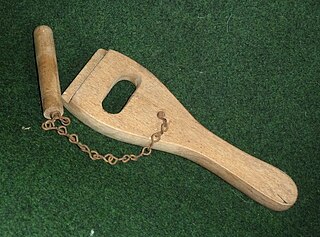
A webbing stretcher is an upholstery tool used to stretch webbing.
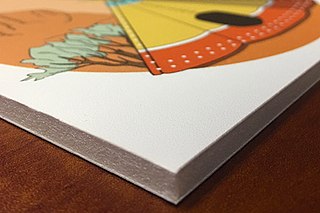
Foamcore, foam board, or paper-faced foam board is a lightweight and easily cut material used for mounting of photographic prints, as backing for picture framing, for making scale models, and in painting. It consists of a board of polystyrene foam clad with an outer facing of paper on either side, typically white clay-coated paper or brown kraft paper.

Frame and panel construction, also called rail and stile, is a woodworking technique often used in the making of doors, wainscoting, and other decorative features for cabinets, furniture, and homes. The basic idea is to capture a 'floating' panel within a sturdy frame, as opposed to techniques used in making a slab solid wood cabinet door or drawer front, the door is constructed of several solid wood pieces running in a vertical or horizontal direction with exposed endgrains. Usually, the panel is not glued to the frame but is left to 'float' within it so that seasonal movement of the wood comprising the panel does not distort the frame.
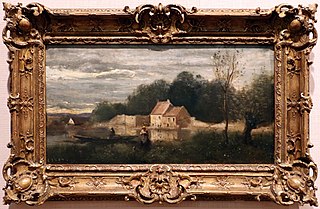
A picture frame is a protective and decorative edging for a picture, such as a painting or photograph. It makes displaying the work safer and easier and both sets the picture apart from its surroundings and aesthetically integrates it with them.

Rabbit-skin glue is a sizing that also acts as an adhesive. It is a type of animal glue that is essentially refined rabbit collagen. The glue has been used for centuries for stretching and priming canvases for oil painting. It has also been an ingredient in traditional gesso.

A violin consists of a body or corpus, a neck, a finger board, a bridge, a soundpost, four strings, and various fittings. The fittings are the tuning pegs, tailpiece and tailgut, endpin, possibly one or more fine tuners on the tailpiece, and in the modern style of playing, usually a chinrest, either attached with the cup directly over the tailpiece or to the left of it. There are many variations of chinrests: center-mount types such as Flesch or Guarneri, clamped to the body on both sides of the tailpiece, and side-mount types clamped to the lower bout to the left of the tailpiece.

Gallery wrap is a method of stretching an artist's canvas so that the canvas wraps around the sides of the stretcher bar or strainer bars and is secured to the back of the wooden frame.
This glossary of woodworking lists a number of specialized terms and concepts used in woodworking, carpentry, and related disciplines.

A canvas print is the result of an image printed onto canvas which is often stretched, or gallery-wrapped, onto a frame and displayed. Canvas prints are used as the final output in an art piece, or as a way to reproduce other forms of art.

A strainer bar is used to construct a wooden stretcher frame used by artists to mount their canvases. They are traditionally a wooden framework support on which an artist fastens a piece of canvas. They are also used for small-scale embroidery to provide steady tension, affixing the edges of the fabric with push-pins or a staple gun before beginning to sew, and then removing it from the frame when the work is complete. Strainer bar frames are usually in the shape of a rectangle, although shaped canvases are also possible.
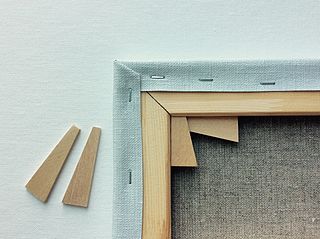
A tightening key is a small wedge or shim used in the construction of a canvas stretcher frame with expandable joints. The key is inserted into the slotted inside the stretcher bars at the mitered corners of the frame to prevent or adjust sagging. Tightening keys are commonly made in plastic or wood, and are often called corner keys or corner wedges. Tightening keys were introduced in the mid-18th century, making expandable stretcher frames possible.
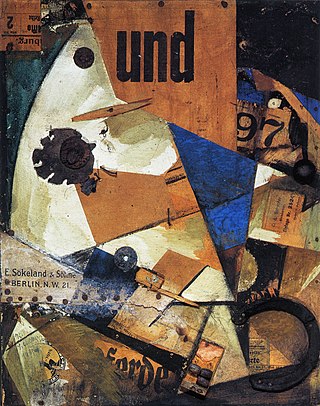
Collage is a technique of art creation, primarily used in the visual arts, but in music too, by which art results from an assemblage of different forms, thus creating a new whole.
The lining of paintings is a process of conservation science and art restoration used to strengthen, flatten or consolidate oil or tempera paintings on canvas by attaching a new support to the back of the existing one. The process is sometimes referred to as relining. Most often a new support will be added directly to the back of an existing canvas. In cases of extreme decay, however, the original canvas may be completely removed and replaced. The height of the practice's use peaked in the late 19th century and in the following years its usefulness has been debated. There are many different factors that influence whether lining a painting will be successful. By paying close attention to an artwork's condition and response to treatment, conservation professionals better understand the lining process and when to apply it.

The conservation and restoration of paintings is carried out by professional painting conservators. Paintings cover a wide range of various mediums, materials, and their supports. Painting types include fine art to decorative and functional objects spanning from acrylics, frescoes, and oil paint on various surfaces, egg tempera on panels and canvas, lacquer painting, water color and more. Knowing the materials of any given painting and its support allows for the proper restoration and conservation practices. All components of a painting will react to its environment differently, and impact the artwork as a whole. These material components along with collections care will determine the longevity of a painting. The first steps to conservation and restoration is preventive conservation followed by active restoration with the artist's intent in mind.
